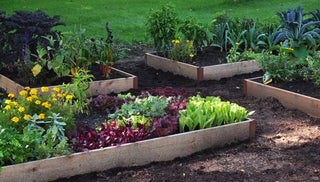 Our front-yard garden is just outside the doors of our administration office in Burlington, VT. See the plans.
Our front-yard garden is just outside the doors of our administration office in Burlington, VT. See the plans.
In front yards across America, most people grow and harvest the same crop: turfgrass. They water it constantly. They feed it regularly. And every week or two, they cut it and throw it away. All of this work for an inedible harvest! How about trading time on the mower for time tending crops you can actually eat?
After all, there's not much that's "natural" about a front lawn. It's a monoculture that's rare in nature but standard in most neighborhoods. Upgrading your front yard to a vegetable garden is sure to raise a few eyebrows, but if you do it right, you'll impress the skeptics.
The goal is to keep it manageable, neat and productive. The truth is, vegetable gardens are not always pretty. Pests and blights can lead to less-than-perfect foliage and fruit. Nothing like a little blossom-end rot to ruin a ripening tomato. To keep the garden looking good, vegetables require a bit of effort and experimentation. You can be sure there will be failures, triumphs and surprises. And in the end, there will be food you can eat!
Will it Work in Your Yard?
Time. It's fine to dream big, but be realistic about how much time you have to spend in the garden — and how much your family members will help out. Start with a scalable plan, so you can expand in the seasons to come.
Sun. Most crops need a full day of sun to thrive, although some can get by with less. If your front yard gets less than eight hours of sun a day, consider shade-tolerant crops, such as salad greens. Another option: Put your planters on casters or platforms with wheels so you can follow the sun.
Water. Your garden will need it regularly, so have a plan in place for frequent watering. Consider setting up a soaker system to make it easy and efficient.
In-ground or raised beds? Although your site might allow in-ground planting, raised beds are a better choice because they reduce weeding chores and concentrate crops in easy-to-manage blocks. They also allow you to bring in fresh topsoil, a boon on sites where soil may be unhealthy due to road salt or other contaminants. Raised beds also frame your garden for a more manicured look that may stave off complaints from lawn-loving neighbors.
Regulations. Some communities and homeowners' associations restrict the amount of non-lawn space they allow in front yards. Before you dig, make sure that there are no regulations in your area that prevent you from having a front-yard vegetable garden. Fortunately, the tide is changing to allow for more creative use of front yards.
 Canadians Michel Beauchamp and Jose Landry had to work with local officials to get approval for a front-yard vegetable garden.
Canadians Michel Beauchamp and Jose Landry had to work with local officials to get approval for a front-yard vegetable garden.
Making a Plan
Once you've decided how much you can take on, sketch a plan on graph paper, or use our free online Kitchen Garden Planner, which uses square-foot gardening techniques to create gardens. Make raised beds that no more than 4 feet wide, so they're easy to access from the sides. Many crops will thrive in containers, so consider using those, too.
Raised beds are available as complete kits, or you can build your own with lumber sourced locally. Keep in mind that naturally rot-resistant lumber is best. The chemicals used to preserve pressure-treated lumber or railroad ties can have an adverse affect on the soil life.
 The Salsa Garden is one of dozens of gardens designed using square-foot gardening techniques. Choose one a preplanned garden or design your own.
The Salsa Garden is one of dozens of gardens designed using square-foot gardening techniques. Choose one a preplanned garden or design your own.Use the Soil Calculator to figure out how much soil you will need. Although it might seem practical and thrifty to fill containers and raised beds with soil gleaned from your landscape, it's usually a bad idea. Most soils are too heavy and drain too slowly for optimal plant growth. You'll be asking a lot from your raised beds, so start them off right with a high-quality planting mix. Containers and smaller beds can be filled with bagged potting soil. For large raised beds, it may make sense to order a delivery of topsoil from a local garden center and mix it with a generous amount of compost.
As you consider the layout of your beds, determine how you will keep the plants watered. Watering by hand might be manageable for a small garden, but in many cases an automatic watering system is more practical — especially if summer vacations are in the forecast. Our Snip-n-Drip Soaker Systems can be customized to fit just about any size bed or container. Add a timer for "set it and forget it" watering all season long.
 Cascading-style cherry tomatoes are a good fit for small vegetable gardens.
Cascading-style cherry tomatoes are a good fit for small vegetable gardens.The Plants
Choose vegetable varieties that remain relatively compact side. For instance, it's probably not a good idea to grow a typical winter squash, which sends out 10- to 20-foot vines. Instead look for "bush-type" varieties that produce crops in much less space. For ideas, explore the Vegetable Encyclopedia and review the plan for our front yard garden here at Gardener's Supply. You'll find more suggestions in the article Top Crops for Small Vegetable Gardens. If you're using a lot of containers, read Urban Gardening with Vegetables for tips and suggestions.


 A
A


